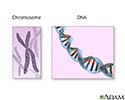Williams syndrome
Williams-Beuren syndrome; WBS; Beuren syndrome; 7q11.23 deletion syndrome; Elfin facies syndrome
Williams syndrome is a rare disorder that can lead to problems with development.
Causes
Williams syndrome is caused by not having a copy of 25 to 27 genes on chromosome number 7.
- In most cases, the gene changes occur on their own, either in the sperm or egg that a baby develops from.
- However, once someone carries the genetic change, their children have a 50% chance of inheriting it.
One of the missing genes is the gene that produces elastin. This is a protein that allows blood vessels and other tissues in the body to stretch. It is likely that missing a copy of this gene results in the narrowing of blood vessels, stretchy skin, and flexible joints seen in this condition.
Symptoms
Symptoms of Williams syndrome are:
- Feeding problems, including colic, reflux, and vomiting
- Inward bend of the small finger
- Sunken chest
- Heart disease or blood vessel problems
- Developmental delay, mild to moderate intellectual disability, learning disorders
- Delayed speech that may later turn into strong speaking ability and strong learning by hearing
- Easily distracted, attention deficit hyperactivity disorder (ADHD)
- Personality traits including being very friendly, trusting strangers, fearing loud sounds or physical contact, and being interested in music
- Short height, compared to the rest of the person's biologic relatives
The face and mouth of someone with Williams syndrome may show:
- A flattened nasal bridge with small, upturned nose
- Long ridges in the skin that run from the nose to the upper lip
- Prominent lips with an open mouth
- Skin that covers the inner corner of the eye
- Partially missing teeth, defective tooth enamel, or small, widely spaced teeth
Exams and Tests
Tests for Williams syndrome include:
- Blood pressure check
- Genetic testing, such as a blood test for a missing piece of chromosome 7 (FISH test or microarray)
- Urine and blood tests for calcium level
- Echocardiography combined with Doppler ultrasound
- Kidney ultrasound
Exams and tests may find the following signs:
- Narrowing of some blood vessels
- Farsightedness
- Dental problems, such as teeth that are widely spaced
- High blood calcium level that may cause seizures and rigid muscles
- High blood pressure
- Loose joints that may change to stiffness as the person gets older
- Unusual star-like pattern in iris of the eye
Treatment
There is no cure for Williams syndrome. Avoid taking extra calcium and vitamin D. Treat high blood calcium if it occurs. Blood vessel narrowing can be a major health problem. Treatment is based on how severe it is.
Physical therapy is helpful for people with joint stiffness. Developmental and speech therapy can also help. For example, having strong verbal skills can help make up for other problems. Other treatments are based on the person's symptoms.
It can help to have treatment coordinated by a geneticist who is experienced with Williams syndrome.
Support Groups
More information and support for people with Williams syndrome and their families can be found at:
Williams Syndrome Association -- williams-syndrome.org
Outlook (Prognosis)
Most people with Williams syndrome:
- Have some intellectual disability.
- May have a shortened lifespan due to the various medical issues and other possible complications.
- Require full-time caregivers and often live with supervision.
Possible Complications
Complications may include:
- Calcium deposits in the kidney and other kidney problems
- Death (in rare cases from anesthesia)
- Heart failure due to narrowed blood vessels
- Pain in the abdomen
When to Contact a Medical Professional
Many of the symptoms and signs of Williams syndrome may not be obvious at birth. Contact your health care provider if your child has features similar to those of Williams syndrome. Seek genetic counseling if you have a family history of Williams syndrome.
Prevention
There is no known way to prevent the genetic problem that causes Williams syndrome. Prenatal testing is available for couples with a family history of Williams syndrome who wish to conceive.
References
Bockenhauer D. Fluid, electrolyte, and acid-base disorders in children. In: Yu ASL, Chertow GM, Luyckx VA, Marsden PA, Skorecki K, Taal MW, eds. Brenner and Rector's The Kidney. 11th ed. Philadelphia, PA: Elsevier; 2020:chap 73.
Morris CA. Williams syndrome. In: Adam MP, Feldman J, Mirzaa GM, et al, eds. GeneReviews. University of Washington, Seattle, WA. www.ncbi.nlm.nih.gov/books/NBK1249/. Updated April 13, 2023. Accessed April 19, 2024.
National Organization for Rare Disorders website. Williams syndrome. rarediseases.org/rare-diseases/williams-syndrome/. Accessed April 19, 2024.
Review Date: 12/31/2023
Reviewed By: Anna C. Edens Hurst, MD, MS, Associate Professor in Medical Genetics, The University of Alabama at Birmingham, Birmingham, AL. Review provided by VeriMed Healthcare Network. Also reviewed by David C. Dugdale, MD, Medical Director, Brenda Conaway, Editorial Director, and the A.D.A.M. Editorial team.









